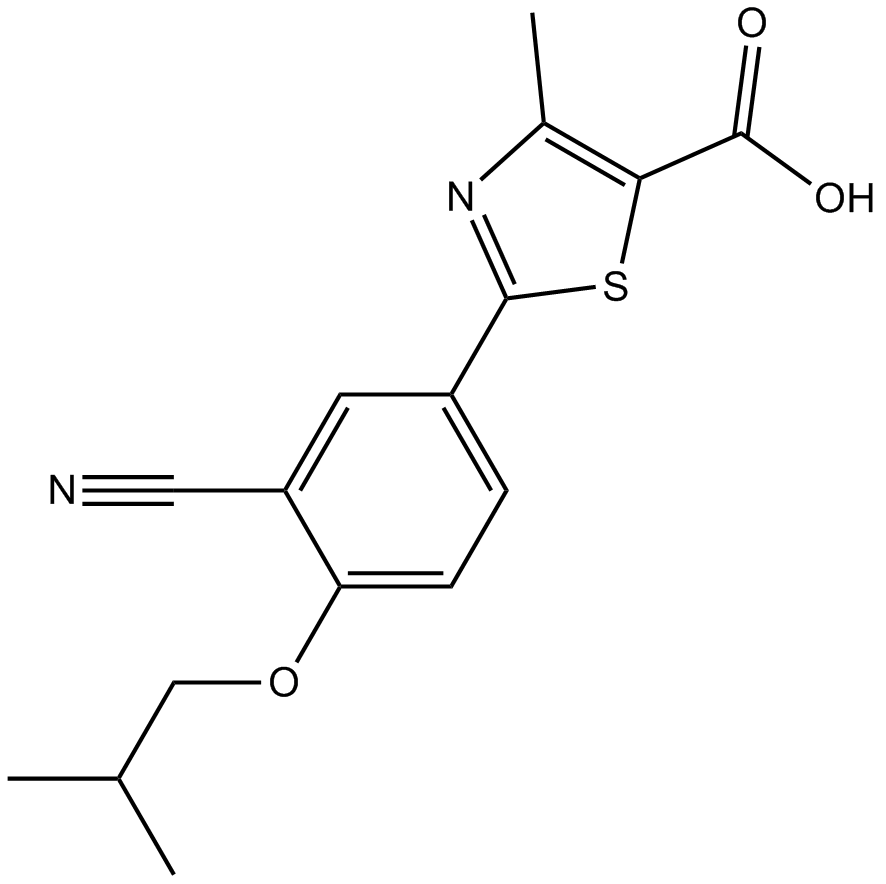Febuxostat (Synonyms: FBX, TEI 6720, TMX 67) |
| Catalog No.GC16319 |
non-purine selective inhibitor of xanthine oxidase
Products are for research use only. Not for human use. We do not sell to patients.

Cas No.: 144060-53-7
Sample solution is provided at 25 µL, 10mM.
IC50: Febuxostat displayed potent mixed-type inhibition of the activity of xanthine oxidase (XO), with Ki value of 0.6 nM [1]. Febuxostat was also reported to be 1000-fold (IC50=1.8 nM) more potent than allopurinol (IC50= 2.9 μM) at inhibiting XO-dependent uric acid formation [2].
Xanthine oxidase is a critical source of reactive oxygen species which contribute to vascular inflammation. Febuxostat is a non-purine selective inhibitor of xanthine oxidase. It works by non-competitively blocking the molybdenum pterin center which is the active site on xanthine oxidase. Xanthine oxidase is needed to successively oxidize both hypoxanthine and xanthine to uric acid. Hence, febuxostat inhibits xanthine oxidase, therefore reducing production of uric acid. Febuxostat inhibits both oxidized as well as reduced form of xanthine oxidase because of which febuxostat cannot be easily displaced from the molybdenum pterin site.
In vitro: In a previous study, the authors investigated the effects of febuxostat on several enzymes in purine and pyrimidine metabolism and characterized the mechanism of febuxostat inhibition of XO activity. Results showed that Febuxostat displayed potent mixed-type inhibition of the activity of purified bovine milk XO, indicating inhibition of both the oxidized and reduced forms of XO. These results demonstrate that febuxostat is a potent non-purine, selective inhibitor of XO, and could be useful for the treatment of hyperuricemia and gout. [1].
In vivo: A study evaluated whether febuxostat (Fx) could alleviate the features of metabolic syndrome as well as the renal hemodynamic alterations and afferent arteriolopathy induced by a high-fructose diet in rats. Compared with fructose, fructose+Fx rats showed significantly lowered blood pressure, UA, triglycerides, and insulin. Moreover, fructose+Fx rats had significantly reduced glomerular pressure, renal vasoconstriction, and afferent arteriolar area relative to fructose rats. These results provide further evidence for a pathogenic role of hyperuricemia in fructose-mediated metabolic syndrome [3].
Clinical trial: Febuxostat (INN; trade names Adenuric in Europe and New Zealand and Uloric in the US) is drug that is indicated for use in the treatment of chronic gout and hyperuricemia. It acts as an inhibitor of xanthine oxidase, thus lowering urate concentrations in the body. Febuxostat received marketing approval by the European Medicines Agency for Menarini on April 21, 2008 and was approved by the U.S. Food and Drug Administration for Takeda on February 16, 2009.
Reference:
[1] Yasuhiro Takano, Kumiko Hase-Aoki, Hideki Horiuchi, Lin Zhao, Yoshinori Kasahara, Shiro Kondo, Michael A. Becker. Selectivity of febuxostat, a novel non-purine inhibitor of xanthine oxidase/xanthine dehydrogenase. Life Sciences 76 (2005) 1835–1847
[2] Umair Z. Malik, Nicholas J. Hundley, Guillermo Romero, Rafael Radi, Bruce A. Freeman, Margaret M. Tarpey, Eric E. Kelley. Febuxostat inhibition of endothelial-bound XO: Implications for targeting vascular ROS production. Free Radical Biol Med 51(2011) 179-184
[3] Laura G. Sa´nchez-Lozada,Edilia Tapia, Pablo Bautista-Garcı´a, Virgilia Soto, Carmen A´ vila-Casado, Iliana P. Vega-Campos, Takahiko Nakagawa, Lin Zhao, Martha Franco, and Richard J. Johnson. Effects of febuxostat on metabolic and renal alterations in rats with fructose-induced metabolic syndrome. Am J Physiol Renal Physiol 294: F710–F718, 2008.
Average Rating: 5 (Based on Reviews and 2 reference(s) in Google Scholar.)
GLPBIO products are for RESEARCH USE ONLY. Please make sure your review or question is research based.
Required fields are marked with *




















